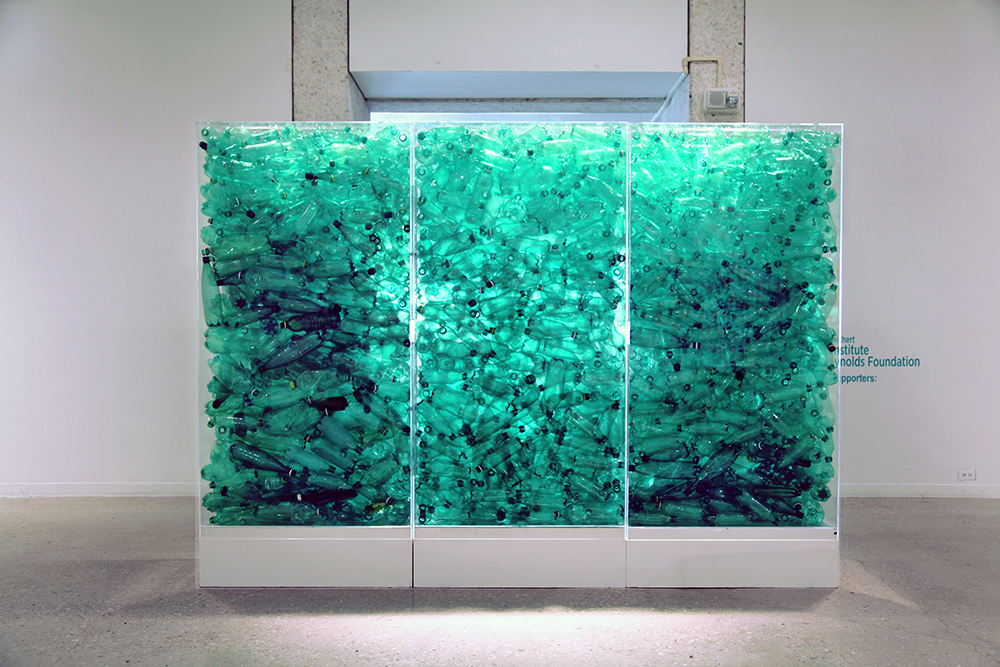The ocean lures us to play, provokes us to awe, and makes us wary of its force. These colossal waters demand our reverence. And yet humans have become most intimately connected to this geography by way of our trash, by way of our thoughtless use of the ocean as an oversized garbage disposal.
I recently moved to the town of Corpus Christi, Texas, which sits directly on Corpus Christi Bay, a short reach from the Gulf of Mexico—the beloved Third Coast. Every day the locals breathe air from this water, finding sweet relief from the heat compliments of the steady breeze that rolls off the water. There is a consciousness here regarding the marine environment that can only arise from a nearness to the coast. The beaches and the Corpus Christi Bay function as the front-yard view to a home, a daily destination for recreation, a faithful landscape during the commute, a research center, or a storm tracker. There is even a university—Texas A&M-Corpus Christi—that sits on its own island, surrounded by both Corpus Christi and Oso Bays. Now that I have become a local, I can confirm that the sea is always present here, always on our minds.
Yet one glance along the bottom of the seawall steps or across the lengths of the sandy beaches and one can’t miss the filth and trash that accumulates from the sheer mindless practices of locals and tourists alike. Plastic grocery bags and other single-use plastic containers, fast-food Styrofoam drink trays, and an unbelievable mass assemblage of other material gather in these places. Some of the trash comes from daily use and discard, some is washed into the bay during rains, and some washes ashore from other cities—or from deep at sea—after tropical storms. It is a terrible cycle of pollution in an environment that desperately needs conservation, but even still, many local grocery chains insist on offering multiple plastic bags for the purchase of one gallon of milk.
An artist who I met early in my time here, Shelia Rogers, calls Corpus Christi her hometown and finds these circumstances intolerable. A self-proclaimed beachcomber, she began collecting, cleaning, and then organizing the trash she found into her art practice. In an effort to highlight the considerable ecological harm that we are perpetuating on our coastlines, she turned these fragments into an entire exhibition, entitled Oceans of Plastic, which she recently presented at the Art Museum of South Texas.
From a distance, the pieces in Rogers’s show take on a life that’s beyond their source material. They appear innocently vibrant and joyful, like a child’s playground. One cannot keep from admiring the aesthetic candy presented at every turn, as each and every contribution sparkles under the gallery lights. Rogers exploits the colorful potency found within her plastic art objects as a seductive device by which to entice us closer and closer to her work.
So come closer.
Ensconced inside the plexiglass displays are the countless pieces of plastic Rogers beachcombed for over several years—fragments of single-use containers or bottles that will never decompose naturally. At the other end of the room are additional display cases, exhibiting plastic soda bottles with gaping holes made by the marine life who cannot differentiate the bottles from an actual food source—many of these animals die from starvation because the plastic fills their stomachs and they are then unable to receive nutrition from normal food. Finally, hanging from the ceiling is an entrancing cotton candyesque sculpture made entirely of monofilament fishing line that has been cut and left to float in the water. Rogers found every piece of this beautiful, horrifying detritus.
Close-up, this is haunting. There is an aesthetic appeal to this trash that can make a heart break, and by displaying this beguiling aesthetic, Rogers pulls back the curtain on a deeper reality of our situation: plastic is made pretty so that we will use it. And we will. We do. All of the time.
Considering the effortlessness with which this one dedicated artist finds plastic remnants on the beaches of Corpus Christi, it is easy to see how problematic our trash consumption and disposal is on a global scale. Rogers is one of many artists who are working in an activist vein to raise our awareness to this dire situation through the presentation of organized material. I find the hope of her exhibit is that she is not working in a vacuum.
Rogers has offered a visual witness to the significant work of local conservation teams and researchers, who are attempting to understand and restore the health of local marine life and who are pushing for changes, such as a plastic bag ban. By partnering with the Harte Research Institute Gulf of Mexico Studies of Texas A&M University-Corpus Christi, this dialogue has expanded among academics, conservationists, artists, museumgoers, and the supportive public alike. Together these individuals are laboring to safeguard the beauty of the place whose name is the Third Coast. This is an incredible conversation to have moved into and an incredible art exhibit to start my journey in South Texas. Thank you, Shelia Rogers—I feel the possibility of refreshing change just as I feel the breeze off of Corpus Christi Bay.
Editor’s Note: For further information regarding local conservation efforts within Corpus Christi, Texas, visit these resources: Coastal Bend Bays Foundation; Coastal Bend Bays and Estuaries Program; Coastal Conservation Association, Corpus Christi Chapter; Harte Research Institute Gulf of Mexico Studies; and Surfrider Foundation.
